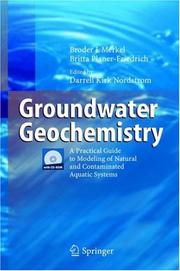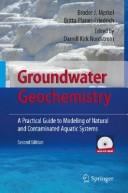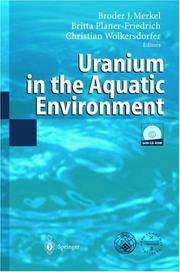| Listing 1 - 8 of 8 |
Sort by
|
Book
ISBN: 3540874690 Year: 2008 Publisher: Berlin, Heidelberg : Springer Berlin Heidelberg : Imprint: Springer,
Abstract | Keywords | Export | Availability | Bookmark
 Loading...
Loading...Choose an application
- Reference Manager
- EndNote
- RefWorks (Direct export to RefWorks)
Auch die zweite Auflage von „Grundwasserchemie" bietet als praxisorientierter Leitfaden einen schnellen Einstieg in die thermodynamische Modellierung. Neben einem minimalen theoretischen Hintergrund liegt der Fokus auf praktischen Beispielen mit dem Computerprogramm PHREEQC. In der Neuauflage sind nun zusätzlich die Möglichkeiten des CD-MUSIC Konzepts zur Oberflächenmodellierung erklärt. Beispiele zum reaktiven Stofftransport umfassen nicht nur den 1d Transport in PHREEQC, sondern auch ein 3d Beispiel mittels PHAST und der graphischen Benutzeroberfläche WPHAST. Unsicherheiten thermodynamischer Daten können mit Hilfe des Programms LJGUNSKILE modelliert werden. Wie in der ersten Auflage helfen detaillierte Beschreibungen der Lösungen dem Nutzer, Schritt für Schritt von einfachen hin zu immer komplexeren hydrogeochemischen Modellierungen zu gelangen. Alle Programme sowie die Lösungen zu den Aufgaben befinden sich auf der CD zum Buch.
Hydrogeology. --- Analytical chemistry. --- Ecotoxicology. --- Analytical Chemistry.

ISBN: 3540272216 3540241957 Year: 2005 Publisher: Berlin, Heidelberg : Springer Berlin Heidelberg : Imprint: Springer,
Abstract | Keywords | Export | Availability | Bookmark
 Loading...
Loading...Choose an application
- Reference Manager
- EndNote
- RefWorks (Direct export to RefWorks)
To understand hydrochemistry and to analyze natural as well as man-made impacts on aquatic systems, hydrogeochemical models have been used since the 1960’s and more frequently in recent times. Numerical groundwater flow, transport, and geochemical models are important tools besides classical deterministic and analytical approaches. Solving complex linear or non-linear systems of equations, commonly with hundreds of unknown parameters, is a routine task for a PC. Modeling hydrogeochemical processes requires a detailed and accurate water analysis, as well as thermodynamic and kinetic data as input. Thermodynamic data, such as complex formation constants and solubility products, are often provided as data sets within the respective programs. However, the description of surface-controlled reactions (sorption, cation exchange, surface complexation) and kinetically controlled reactions requires additional input data. Unlike groundwater flow and transport models, thermodynamic models, in principal, do not need any calibration. However, considering surface-controlled or kinetically controlled reaction models might be subject to calibration. Typical problems for the application of geochemical models are: speciation determination of saturation indices adjustment of equilibria/disequilibria for minerals or gases mixing of different waters modeling the effects of temperature stoichiometric reactions (e.g. titration) reactions with solids, fluids, and gaseous phases (in open and closed systems) sorption (cation exchange, surface complexation) inverse modeling kinetically controlled reactions reactive transport Hydrogeochemical models are dependent on the quality of the chemical analyses, the boundary conditions presumed by the program, theoretical concepts (e.g.
Water chemistry --- Mathematical models. --- Aquatic chemistry --- Chemical hydrology --- Hydrochemistry --- Hydrogeochemistry --- Natural water chemistry --- Geochemistry --- Hydrology --- Hydraulic engineering. --- Geology. --- Analytical biochemistry. --- Geography. --- Hydrogeology. --- Water Quality/Water Pollution. --- Analytical Chemistry. --- Geotechnical Engineering & Applied Earth Sciences. --- Earth Sciences, general. --- Cosmography --- Earth sciences --- World history --- Analytic biochemistry --- Biochemistry --- Chemistry, Analytic --- Geognosy --- Geoscience --- Natural history --- Engineering, Hydraulic --- Engineering --- Fluid mechanics --- Hydraulics --- Shore protection --- Bioanalytic chemistry --- Bioanalytical chemistry --- Analytical chemistry --- Water quality. --- Water pollution. --- Analytical chemistry. --- Geotechnical engineering. --- Earth sciences. --- Geosciences --- Environmental sciences --- Physical sciences --- Engineering, Geotechnical --- Geotechnics --- Geotechnology --- Engineering geology --- Analysis, Chemical --- Analytic chemistry --- Chemical analysis --- Chemistry --- Aquatic pollution --- Fresh water --- Fresh water pollution --- Freshwater pollution --- Inland water pollution --- Lake pollution --- Lakes --- Reservoirs --- River pollution --- Rivers --- Stream pollution --- Water contamination --- Water pollutants --- Water pollution --- Pollution --- Waste disposal in rivers, lakes, etc. --- Freshwater --- Freshwater quality --- Marine water quality --- Quality of water --- Seawater --- Seawater quality --- Water --- Environmental quality --- Geohydrology --- Geology --- Groundwater --- Quality --- Composition

ISBN: 3540746684 3540746676 9783540746676 9783540746683 Year: 2008 Publisher: Berlin, Heidelberg : Springer Berlin Heidelberg : Imprint: Springer,
Abstract | Keywords | Export | Availability | Bookmark
 Loading...
Loading...Choose an application
- Reference Manager
- EndNote
- RefWorks (Direct export to RefWorks)
To understand hydrochemistry and to analyze natural as well as man-made impacts on aquatic systems, hydrogeochemical models have been used since the 1960’s and more frequently in recent times. Numerical groundwater flow, transport, and geochemical models are important tools besides classical deterministic and analytical approaches. Solving complex linear or non-linear systems of equations, commonly with hundreds of unknown parameters, is a routine task for a PC. Modeling hydrogeochemical processes requires a detailed and accurate water analysis, as well as thermodynamic and kinetic data as input. Thermodynamic data, such as complex formation constants and solubility-products, are often provided as databases within the respective programs. However, the description of surface-controlled reactions (sorption, cation exchange, surface complexation) and kinetically controlled reactions requires additional input data. Unlike groundwater flow and transport models, thermodynamic models, in principal, do not need any calibration. However, considering surface-controlled or kinetically controlled reaction models might be subject to calibration. Typical problems for the application of geochemical models are: • speciation • determination of saturation indices • adjustment of equilibria/disequilibria for minerals or gases • mixing of different waters • modeling the effects of temperature • stoichiometric reactions (e.g. titration) • reactions with solids, fluids, and gaseous phases (in open and closed systems) • sorption (cation exchange, surface complexation) • inverse modeling • kinetically controlled reactions • reactive transport Hydrogeochemical models depend on the quality of the chemical analysis, the boundary conditions presumed by the program, theoretical concepts (e.g.
Water chemistry --- Mathematical models. --- Aquatic chemistry --- Chemical hydrology --- Hydrochemistry --- Hydrogeochemistry --- Natural water chemistry --- Geochemistry --- Hydrology --- Hydraulic engineering. --- Analytical biochemistry. --- Geography. --- Environmental toxicology. --- Hydrogeology. --- Hydrology/Water Resources. --- Analytical Chemistry. --- Geotechnical Engineering & Applied Earth Sciences. --- Earth Sciences, general. --- Ecotoxicology. --- Ecotoxicology --- Pollutants --- Pollution --- Environmental health --- Toxicology --- Cosmography --- Earth sciences --- World history --- Analytic biochemistry --- Biochemistry --- Chemistry, Analytic --- Engineering, Hydraulic --- Engineering --- Fluid mechanics --- Hydraulics --- Shore protection --- Bioanalytic chemistry --- Bioanalytical chemistry --- Analytical chemistry --- Hydrology. --- Analytical chemistry. --- Geotechnical engineering. --- Earth sciences. --- Geosciences --- Environmental sciences --- Physical sciences --- Engineering, Geotechnical --- Geotechnics --- Geotechnology --- Engineering geology --- Analysis, Chemical --- Analytic chemistry --- Chemical analysis --- Chemistry --- Aquatic sciences --- Hydrography --- Water --- Geohydrology --- Geology --- Groundwater --- Water chemistry - Mathematical models
Digital
ISBN: 9783540272212 Year: 2005 Publisher: Berlin, Heidelberg Springer-Verlag Berlin Heidelberg
Abstract | Keywords | Export | Availability | Bookmark
 Loading...
Loading...Choose an application
- Reference Manager
- EndNote
- RefWorks (Direct export to RefWorks)
Analytical chemistry --- Geology. Earth sciences --- Water supply. Water treatment. Water pollution --- Environmental protection. Environmental technology --- Computer. Automation --- hydrologie --- analytische chemie --- informatica --- waterverontreiniging --- milieuzorg --- grondwater --- geologie --- milieubeheer --- milieuanalyse
Digital
ISBN: 9783540746683 Year: 2008 Publisher: Berlin, Heidelberg 2005 Springer-Verlag Berlin Heidelberg
Abstract | Keywords | Export | Availability | Bookmark
 Loading...
Loading...Choose an application
- Reference Manager
- EndNote
- RefWorks (Direct export to RefWorks)
Analytical chemistry --- Geology. Earth sciences --- General ecology and biosociology --- Toxicology --- Water supply. Water treatment. Water pollution --- Computer. Automation --- hydrologie --- ecotoxicologie --- analytische chemie --- farmacologie --- informatica --- toxicologie --- waterverontreiniging --- grondwater --- geologie

ISBN: 3540439277 Year: 2002 Publisher: Berlin ; Heidelberg ; New York, NY : Springer-Verlag,
Abstract | Keywords | Export | Availability | Bookmark
 Loading...
Loading...Choose an application
- Reference Manager
- EndNote
- RefWorks (Direct export to RefWorks)
Book
Year: 2002 Publisher: Berlin ; Heidelberg : Springer,
Abstract | Keywords | Export | Availability | Bookmark
 Loading...
Loading...Choose an application
- Reference Manager
- EndNote
- RefWorks (Direct export to RefWorks)
Book
ISBN: 9783540272212 Year: 2005 Publisher: Berlin Heidelberg Springer Berlin Heidelberg
Abstract | Keywords | Export | Availability | Bookmark
 Loading...
Loading...Choose an application
- Reference Manager
- EndNote
- RefWorks (Direct export to RefWorks)
To understand hydrochemistry and to analyze natural as well as man-made impacts on aquatic systems, hydrogeochemical models have been used since the 1960's and more frequently in recent times. Numerical groundwater flow, transport, and geochemical models are important tools besides classical deterministic and analytical approaches. Solving complex linear or non-linear systems of equations, commonly with hundreds of unknown parameters, is a routine task for a PC. Modeling hydrogeochemical processes requires a detailed and accurate water analysis, as well as thermodynamic and kinetic data as input. Thermodynamic data, such as complex formation constants and solubility products, are often provided as data sets within the respective programs. However, the description of surface-controlled reactions (sorption, cation exchange, surface complexation) and kinetically controlled reactions requires additional input data. Unlike groundwater flow and transport models, thermodynamic models, in principal, do not need any calibration. However, considering surface-controlled or kinetically controlled reaction models might be subject to calibration. Typical problems for the application of geochemical models are: speciation determination of saturation indices adjustment of equilibria/disequilibria for minerals or gases mixing of different waters modeling the effects of temperature stoichiometric reactions (e.g. titration) reactions with solids, fluids, and gaseous phases (in open and closed systems) sorption (cation exchange, surface complexation) inverse modeling kinetically controlled reactions reactive transport Hydrogeochemical models are dependent on the quality of the chemical analyses, the boundary conditions presumed by the program, theoretical concepts (e.g.
Analytical chemistry --- Geology. Earth sciences --- Water supply. Water treatment. Water pollution --- Environmental protection. Environmental technology --- Computer. Automation --- hydrologie --- analytische chemie --- informatica --- waterverontreiniging --- milieuzorg --- grondwater --- geologie --- milieubeheer --- milieuanalyse
| Listing 1 - 8 of 8 |
Sort by
|

 Search
Search Feedback
Feedback About
About Help
Help News
News